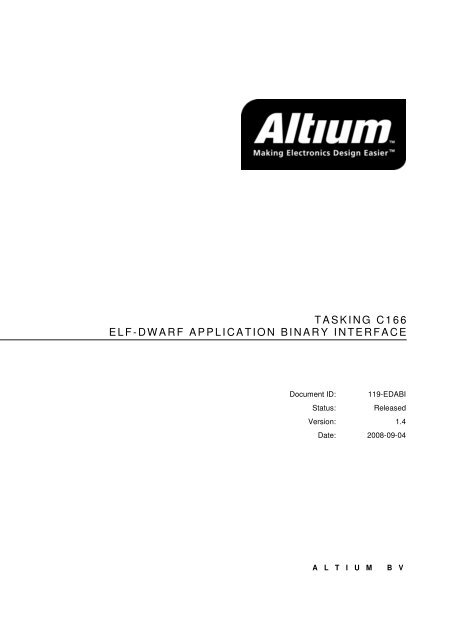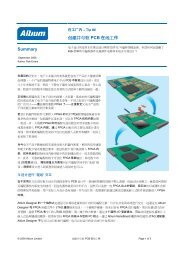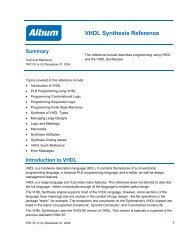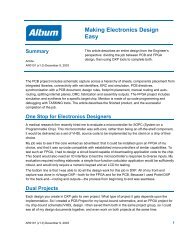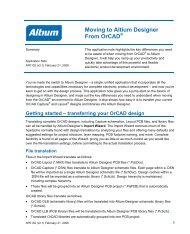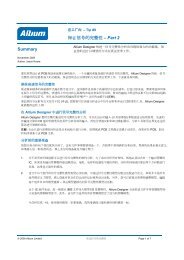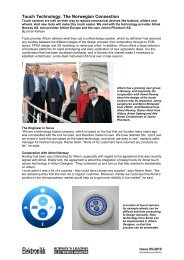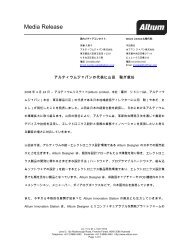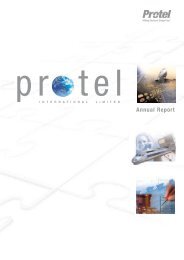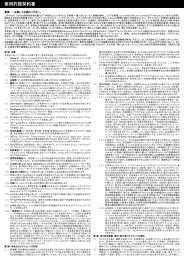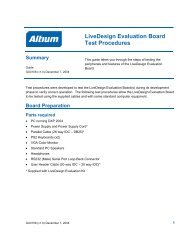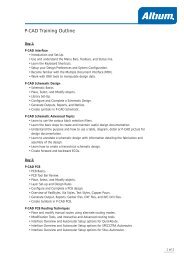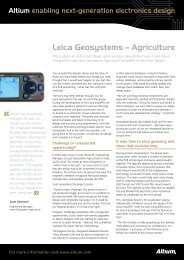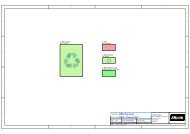TASKING C166 ELF-DWARF APPLICATION BINARY INTERFACE
TASKING C166 ELF-DWARF APPLICATION BINARY INTERFACE
TASKING C166 ELF-DWARF APPLICATION BINARY INTERFACE
You also want an ePaper? Increase the reach of your titles
YUMPU automatically turns print PDFs into web optimized ePapers that Google loves.
T A SKING <strong>C166</strong><br />
E L F -DW A R F <strong>APPLICATION</strong> <strong>BINARY</strong> <strong>INTERFACE</strong><br />
Document ID: 119-EDABI<br />
Status: Released<br />
Version: 1.4<br />
Date: 2008-09-04<br />
A L T I U M B V
<strong>TASKING</strong> <strong>C166</strong><br />
<strong>ELF</strong>-<strong>DWARF</strong> <strong>APPLICATION</strong> <strong>BINARY</strong> <strong>INTERFACE</strong><br />
Contents<br />
Introduction........................................................................................................................................4<br />
1 <strong>ELF</strong> Implementation ..................................................................................................................4<br />
1.1 <strong>ELF</strong> Header ...........................................................................................................................4<br />
1.1.1 e_ident field..................................................................................................................4<br />
1.1.2 E_MACHINE...................................................................................................................4<br />
1.1.3 E_FLAGS ........................................................................................................................4<br />
1.2 <strong>ELF</strong> Section Attribute Flags...............................................................................................5<br />
1.3 Address Spaces ...................................................................................................................7<br />
1.4 Relocation Expression Stack.............................................................................................8<br />
2 <strong>DWARF</strong> Debug Information....................................................................................................10<br />
2.1 <strong>DWARF</strong> register mapping ................................................................................................10<br />
2.2 Function Attributes ...........................................................................................................11<br />
2.2.1 <strong>DWARF</strong> Function Calling Convention.....................................................................11<br />
2.3 <strong>TASKING</strong> Type Qualifier Extensions..............................................................................11<br />
2.3.1 Version 1 .....................................................................................................................11<br />
2.3.2 Version 2 .....................................................................................................................12<br />
2.4 __unaligned and __packed__ ........................................................................................12<br />
2.5 Call Frame Information....................................................................................................12<br />
2.5.1 Call Stack and Memory Models...............................................................................12<br />
2.5.1.1 Basic Facts ...............................................................................................................13<br />
2.5.1.2 Pending Issues........................................................................................................13<br />
2.5.1.3 Known Limitations..................................................................................................13<br />
2.5.1.4 Near Functions, Return Address on System-Stack.........................................13<br />
2.5.1.5 Huge Functions, Return Address on System-Stack ........................................13<br />
2.5.1.6 Near Functions, Return Address on User-Stack ..............................................14<br />
2.5.1.7 Huge functions, Return Address on User-Stack ..............................................14<br />
2.5.1.8 Interrupt Functions ................................................................................................14<br />
2.5.2 Self-containedness ....................................................................................................15<br />
2.5.3 Addresses ....................................................................................................................15<br />
2.5.4 Definition of CFA ........................................................................................................15<br />
2.5.5 Determining the Return Address............................................................................15<br />
2.5.6 Determining Stack Pointer Register Values .........................................................16<br />
2.5.7 SPSEG ..........................................................................................................................16<br />
2.5.8 Near Data Addresses ................................................................................................16<br />
3 Code compaction......................................................................................................................17<br />
3.1 Introduction .......................................................................................................................17<br />
3.2 Line information ................................................................................................................17<br />
3.3 Execution control ..............................................................................................................18<br />
3.4 Variable access..................................................................................................................18<br />
119-EDABI 1.4 Released page 2 of 19 2008-09-04
<strong>TASKING</strong> <strong>C166</strong><br />
<strong>ELF</strong>-<strong>DWARF</strong> <strong>APPLICATION</strong> <strong>BINARY</strong> <strong>INTERFACE</strong><br />
Revision History<br />
• v1.0: Initial version<br />
• v1.1: Version made available with the last v1.0 beta of the <strong>TASKING</strong> VX-toolset for<br />
<strong>C166</strong>. Switched formally to <strong>DWARF</strong> 3.0<br />
• v1.2: First used in <strong>TASKING</strong> VX-toolset for <strong>C166</strong> v2.1r1. Added<br />
SHF_<strong>TASKING</strong>_PROTECTED. Changed values of EF_<strong>C166</strong>_DATA_*. Added<br />
return_address_register in <strong>DWARF</strong> information. Updated call stack frame section.<br />
• v1.3: First used in <strong>TASKING</strong> VX-toolset for <strong>C166</strong> v2.1r2. Removed RLn, RHn and<br />
Rn.m from the <strong>DWARF</strong> register mapping. Updated call stack frame section. Many<br />
changes in the <strong>DWARF</strong> Call Frame Information<br />
• v1.4: First used in <strong>TASKING</strong> VX-toolset for <strong>C166</strong> v2.3r1. Added new<br />
DW_AT_address_class attribute table. Documented use of DW_TAG_packed_type.<br />
Added section about code compaction.<br />
119-EDABI 1.4 Released page 3 of 19 2008-09-04
<strong>TASKING</strong> <strong>C166</strong><br />
<strong>ELF</strong>-<strong>DWARF</strong> <strong>APPLICATION</strong> <strong>BINARY</strong> <strong>INTERFACE</strong><br />
Introduction<br />
This document describes the implementation of the <strong>ELF</strong> object format and<br />
the <strong>DWARF</strong> 3 debug information for the <strong>TASKING</strong> VX-toolset for <strong>C166</strong>.<br />
The implementation is based on:<br />
• System V Application Binary Interface - DRAFT - 17 December 2003<br />
see http://www.caldera.com/developers/gabi/2003-12-17/contents.html<br />
• <strong>DWARF</strong> Debugging Information Format, Version 3, December 20, 2005<br />
see http://dwarf.freestandards.org<br />
1 <strong>ELF</strong> Implementation<br />
1.1 <strong>ELF</strong> Header<br />
The following paragraphs define <strong>C166</strong> specific items in the <strong>ELF</strong> header.<br />
1.1.1 e_ident field<br />
The e_ident field values are defined as follows:<br />
Field Value Description<br />
e_ident[EI_CLASS] <strong>ELF</strong>CLASS32 Identifies 32 bit architecture.<br />
e_ident[EI_DATA] <strong>ELF</strong>DATA2LSB Identifies 2's complement little endian data<br />
encoding.<br />
1.1.2 E_MACHINE<br />
The E_MACHINE is defined as follows:<br />
E_MACHINE Value Description<br />
EM_<strong>C166</strong> 116 Infineon C16x/XC16x processor<br />
1.1.3 E_FLAGS<br />
The E_FLAGS field will be used to distinguish between memory models and<br />
extended architectures:<br />
119-EDABI 1.4 Released page 4 of 19 2008-09-04
<strong>TASKING</strong> <strong>C166</strong><br />
<strong>ELF</strong>-<strong>DWARF</strong> <strong>APPLICATION</strong> <strong>BINARY</strong> <strong>INTERFACE</strong><br />
Bit Type Values Meaning<br />
0-3 EF_<strong>C166</strong>_CORE_UNDEFINED 0 Architecture not defined<br />
EF_<strong>C166</strong>_CORE_8X166 1 Classic 8x<strong>C166</strong><br />
EF_<strong>C166</strong>_CORE_C16X 2 Infineon C16x<br />
EF_<strong>C166</strong>_CORE_ST10 3 STMicroelectronics ST10<br />
EF_<strong>C166</strong>_CORE_ST10MAC 4 STMicroelectronics ST10 with MAC unit<br />
(e.g., ST10x272)<br />
EF_<strong>C166</strong>_CORE_XC16X 5 Infineon XC16X<br />
EF_<strong>C166</strong>_CORE_SUPER10 6 STMicroelectronics Super10<br />
EF_<strong>C166</strong>_CORE_SUPER10M345 7 STMicroelectronics Super10M345 and<br />
derivatives<br />
EF_<strong>C166</strong>_CORE_<strong>C166</strong>SV1 8 Infineon <strong>C166</strong>S V1 core<br />
9-15 reserved for future use<br />
4-7 EF_<strong>C166</strong>_DATA_UNDEFINED 0 Data model not defined<br />
EF_<strong>C166</strong>_DATA_NEAR 1 Near data model<br />
EF_<strong>C166</strong>_DATA_FAR 2 Far data model<br />
EF_<strong>C166</strong>_DATA_SHUGE 3 Segmented huge data model<br />
EF_<strong>C166</strong>_DATA_HUGE 4 Huge data model<br />
5-15 reserved for future use<br />
8-<br />
10<br />
EF_<strong>C166</strong>_CODE_UNDEFINED 0 Code model not defined<br />
EF_<strong>C166</strong>_CODE_HUGE 1 Code model with huge functions<br />
EF_<strong>C166</strong>_CODE_NEAR 2 Code model with near functions<br />
3-7 reserved for future use<br />
11 EF_<strong>C166</strong>_SYSTEM_STACK 0 System stack is used as default for<br />
return values<br />
EF_<strong>C166</strong>_USER_STACK 1 User stack is used as default for return<br />
values<br />
12 EF_<strong>C166</strong>_FLOAT_DOUBLE 0 Double precission floating point is<br />
treated as double precission<br />
EF_<strong>C166</strong>_FLOAT_NODOUBLE 1 Double precission floating point is<br />
treated as single precission<br />
13-<br />
31<br />
0 Reserved for future use<br />
1.2 <strong>ELF</strong> Section Attribute Flags<br />
Section attribute flags are defined in the sh_flags field of the section<br />
header record. The <strong>TASKING</strong> defined flags are in the SHF_MASKOS or the<br />
SFR_MASKPROC range:<br />
119-EDABI 1.4 Released page 5 of 19 2008-09-04
<strong>TASKING</strong> <strong>C166</strong><br />
<strong>ELF</strong>-<strong>DWARF</strong> <strong>APPLICATION</strong> <strong>BINARY</strong> <strong>INTERFACE</strong><br />
Name Value<br />
SHF_MASKOS 0x0FF00000<br />
SHF_MASKPROC 0xF0000000<br />
SHF_<strong>TASKING</strong>_PROTECTED 0x08000000<br />
SHF_<strong>TASKING</strong>_ABSOLUTE 0x10000000<br />
SHF_<strong>TASKING</strong>_SEPARATE 0x20000000<br />
SHF_<strong>TASKING</strong>_NOCLEAR 0x40000000<br />
SHF_<strong>TASKING</strong>_PAGED 0x80000000<br />
SHF_<strong>TASKING</strong>_PROTECTED<br />
Sections with this flag set are protected. Sections with the<br />
SHF_<strong>TASKING</strong>_PROTECTED flag set are excluded from unreferenced<br />
section removal and duplicate section removal.<br />
SHF_<strong>TASKING</strong>_ABSOLUTE<br />
Sections with this flag set are absolute. The sh_addr field in the section<br />
header contains the absolute address.<br />
SHF_<strong>TASKING</strong>_SEPARATE<br />
Sections with the same type, attributes and name are concatenated by the<br />
linker. Sections with the SHF_<strong>TASKING</strong>_SEPARATE flag set will not be<br />
concatenated.<br />
SHF_<strong>TASKING</strong>_NOCLEAR<br />
These sections must have type SHT_NOBITS. Normally, sections of this<br />
type must be cleared on startup, but sections with the flag<br />
SHF_<strong>TASKING</strong>_NOCLEAR set should not be cleared.<br />
SHF_<strong>TASKING</strong>_PAGED<br />
Sections with this flag set are relocatable, the sh_addr field in the section<br />
header is interpreted as a page size by the linker. The section must be<br />
located within a page of this size. Pages start at a multiple of the page<br />
size. If the section name is of the form "name@group", the linker must<br />
place all sections with the same group postfix in the same page. The size<br />
of the page depends on the section type and address space.<br />
'Max sections'<br />
When the SHF_MERGE flag is set in combination with the<br />
SHF_<strong>TASKING</strong>_NOCLEAR flag, all sections with the same name type and<br />
flags are combined into a single section, with size equal to the largest<br />
input section. This are so-called 'max sections'.<br />
Note that this only applies to scratch sections.<br />
119-EDABI 1.4 Released page 6 of 19 2008-09-04
<strong>TASKING</strong> <strong>C166</strong><br />
<strong>ELF</strong>-<strong>DWARF</strong> <strong>APPLICATION</strong> <strong>BINARY</strong> <strong>INTERFACE</strong><br />
1.3 Address Spaces<br />
Address space information for sections and symbols that is to be used by<br />
the linker is encoded in<br />
an additional field that is added to the <strong>ELF</strong> section headers and symbol<br />
table entries. If present,<br />
the value for this field must be non-zero for sections that have the<br />
SHF_ALLOC flag set. The<br />
addional address space fields are only present in relocatable <strong>ELF</strong> object<br />
files. The fields are not<br />
present in the absolute <strong>ELF</strong> file as generated by the linker.<br />
The Section Header definition for relocatable object files:<br />
typedef struct {<br />
Elf32_Word sh_name;<br />
Elf32_Word sh_type;<br />
Elf32_Word sh_flags;<br />
Elf32_Addr sh_addr;<br />
Elf32_Off sh_offset;<br />
Elf32_Word sh_size;<br />
Elf32_Word sh_link;<br />
Elf32_Word sh_info;<br />
Elf32_Word sh_addralign;<br />
Elf32_Word sh_entsize;<br />
unsigned char sh_addrspace; // additional address space field<br />
unsigned char sh_reserved[3]; // reserved for future use<br />
} Elf32_Shdr;<br />
The Symbol Table Entry definition for relocatable object files:<br />
typedef struct {<br />
Elf32_Word st_name;<br />
Elf32_Addr st_value;<br />
Elf32_Word st_size;<br />
unsigned char st_info;<br />
unsigned char st_other;<br />
Elf32_Half st_shndx;<br />
unsigned char st_addrspace; // additional address space field<br />
unsigned char st_reserved[3]; // reserved for future use<br />
} Elf32_Sym;<br />
The sh_reserved and st_reserved fields are required to pad to a 32 bit<br />
boundary.<br />
119-EDABI 1.4 Released page 7 of 19 2008-09-04
<strong>TASKING</strong> <strong>C166</strong><br />
<strong>ELF</strong>-<strong>DWARF</strong> <strong>APPLICATION</strong> <strong>BINARY</strong> <strong>INTERFACE</strong><br />
The following address space values are defined:<br />
Space Value<br />
bit 1<br />
bita 2<br />
iram 3<br />
near 4<br />
far 5<br />
shuge 6<br />
huge 7<br />
code 8<br />
1.4 Relocation Expression Stack<br />
For those situations in which the relocation value cannot be expressed as a<br />
simple symbol value plus<br />
an addend, there are three special relocation types (<strong>ELF</strong>32_R_TYPE) used<br />
to evaluate an arbitrary expression on a relocation stack. These relocation<br />
types are referred to as extended relocations. Other relocation types are<br />
ordinary relocations.<br />
A relocation stack is a standard last-in-first-out data structure containing<br />
32-bit values. A hosted environment must not place any arbitrary limit on<br />
the depth of the stack. An embedded environment may impose any limit<br />
on stack depth or omit the relocation stack entirely (effectively, a<br />
maximum stack depth of zero).<br />
A target supporting the relocation expression stack must define the<br />
following relocation types in addition to the target specific relocation types:<br />
Relocation type Value<br />
R_<strong>TASKING</strong>_PUSH 253<br />
R_<strong>TASKING</strong>_OPER 254<br />
R_<strong>TASKING</strong>_POP 255<br />
R_<strong>TASKING</strong>_PUSH<br />
This relocation type indicates that the sum of the symbol value (the value<br />
of symbol number zero is zero) plus the signed r_addend value should be<br />
pushed onto the relocation stack.<br />
R_<strong>TASKING</strong>_OPER<br />
This relocation type defines an operation to be performed on one or more<br />
stack values. The operation is specified by the sum of the symbol value<br />
(the value of symbol number zero is zero) plus the signed r_addend value.<br />
Operations are shown in Table 8. In the table, Stack 0 indicates the value<br />
on the top of the stack, and Stack 1 indicates the value one level beneath<br />
the top of the stack.<br />
119-EDABI 1.4 Released page 8 of 19 2008-09-04
<strong>TASKING</strong> <strong>C166</strong><br />
<strong>ELF</strong>-<strong>DWARF</strong> <strong>APPLICATION</strong> <strong>BINARY</strong> <strong>INTERFACE</strong><br />
R_<strong>TASKING</strong>_POP<br />
Indicates the end of a relocation expression. When the R_<strong>TASKING</strong>_POP<br />
operation is encountered, there should be exactly one value on the stack.<br />
This value, which is consumed by this operation, becomes the new<br />
relocation value for the ordinary relocation type specified in the<br />
R_<strong>TASKING</strong>_POP relocation. The relocation type is specified by the sum of<br />
the symbol value (the value of symbol number zero is zero) plus the<br />
signed r_addend value<br />
It is the responsibility of the relocation engine to ensure that the stack is<br />
empty after a R_<strong>TASKING</strong>_POP, before an ordinary relocation, and after<br />
linking is complete. A sequence of relocations which causes a stack<br />
underflow does not conform to this specification.<br />
The following Relocation Stack Operations are defined:<br />
Relocation<br />
Value<br />
Stack 0<br />
Before<br />
Operation<br />
Stack 1<br />
Before<br />
Operation<br />
Stack 0<br />
After<br />
Operation<br />
Operation<br />
0 X X No operation<br />
1 X -X Negation (2s complement)<br />
2 X ~X Bitwise NOT (1s complement)<br />
3 X !X Boolean NOT (zero ->1, nonzero -> 0)<br />
4 Y X X * Y Multiplication<br />
5 Y X X / Y Division<br />
6 Y X X % Y Remainder<br />
7 Y X X + Y Addition<br />
8 Y X X - Y Subtraction<br />
9 Y X X > Y Logical shift right<br />
11 Y X X > Y Arithmetic shift right<br />
13 Y X X < Y 1 if X < Y, otherwise 0<br />
14 Y X X Y, otherwise 0<br />
16 Y X X >= Y 1 if X >= Y, otherwise 0<br />
17 Y X X == Y 1 if X equals Y, otherwise 0<br />
18 Y X X != Y 1 if X does not equal Y, otherwise 0<br />
19 Y X X & Y Bitwise AND<br />
20 Y X X | Y Bitwise OR<br />
21 Y X X || Y Bitwise XOR<br />
22 Y X X && Y 1 if X and Y both nonzero, otherwise 0<br />
23 Y X X || Y 1 if X or Y or both nonzero, otherwise 0<br />
Note that in most cases, the stack values are treated as unsigned.<br />
However, arithmetic shifts and logical shifts are treated differently.<br />
Logical shift left:<br />
Zeroes are shifted in on the right.<br />
119-EDABI 1.4 Released page 9 of 19 2008-09-04
<strong>TASKING</strong> <strong>C166</strong><br />
<strong>ELF</strong>-<strong>DWARF</strong> <strong>APPLICATION</strong> <strong>BINARY</strong> <strong>INTERFACE</strong><br />
Logical shift right:<br />
Zeroes are shifted in on the left.<br />
Arithmetic shift left:<br />
Zeroes are shifted in on the right, and the most significant bit is always<br />
unaffected. Arithmetic shift right: Copies of the most significant bit are<br />
shifted in on the left<br />
2 <strong>DWARF</strong> Debug Information<br />
The <strong>C166</strong> tool chain uses <strong>DWARF</strong> for passing HLL debug information from<br />
the compiler to the debugger.<br />
2.1 <strong>DWARF</strong> register mapping<br />
<strong>DWARF</strong> represents register names effectively as small integers. These<br />
numbers are used in the OP_REG and OP_BASEREG atoms to locate<br />
values. The mapping of <strong>DWARF</strong> register numbers to the <strong>C166</strong> register set<br />
is as follows.<br />
Register Atom Ranges<br />
Rn a = n 0 < = n < = 15; 0 < = a < = 15<br />
USR0 a a = 288<br />
SP a a = 289<br />
MAC a a = 290<br />
MAH a a = 291<br />
MAL a a = 292<br />
MAE a a = 293<br />
MRW a a = 294<br />
IDX0 a a = 295<br />
IDX1 a a = 296<br />
QX0 a a = 297<br />
QX1 a a = 298<br />
QR0 a a = 299<br />
QR1 a a = 300<br />
CF Info return_address_register a a = 301<br />
IP a a = 302<br />
CSP a a = 303<br />
SPSEG a a = 304<br />
DPP0 a a = 305<br />
DPP1 a a = 306<br />
DPP2 a a = 307<br />
DPP3 a a = 308<br />
Note: the "CF Info return_address_register" register value has been<br />
defined to prevent the number from being used for a regular register in<br />
the future. Otherwise debuggers could run into problems when reading<br />
119-EDABI 1.4 Released page 10 of 19 2008-09-04
<strong>TASKING</strong> <strong>C166</strong><br />
<strong>ELF</strong>-<strong>DWARF</strong> <strong>APPLICATION</strong> <strong>BINARY</strong> <strong>INTERFACE</strong><br />
older objects where the number used for the return_address_register in<br />
the call frame information would overlap with a regular register's number<br />
in newer objects. The "CF Info return_address_register" is a virtual<br />
register and it is not intended to show up in any <strong>DWARF</strong> expression.<br />
2.2 Function Attributes<br />
Function attributes describing the combination of memory model, stack<br />
model and other calling convention details, are conveyed with additional<br />
tool-chain specific values using the <strong>DWARF</strong> calling convention attribute<br />
DW_AT_calling_convention.<br />
2.2.1 <strong>DWARF</strong> Function Calling Convention<br />
Encoding Symbolic Value Meaning<br />
0x01 DW_CC_normal Huge function model, return address on system<br />
stack (default)<br />
0x02 DW_CC_program Not used (see <strong>DWARF</strong> 3 specification)<br />
0x03 DW_CC_nocall Not used (see <strong>DWARF</strong> 3 specification)<br />
0x65 DW_CC_interrupt Function is an interrupt handler, return address<br />
on system stack<br />
0x66 DW_CC_near_system_stack Near function model, return address on system<br />
stack<br />
0x67 DW_CC_near_user_stack Near function model, return address on user<br />
stack<br />
0x68 DW_CC_huge_user_stack Huge function model, return address on user<br />
stack<br />
2.3 <strong>TASKING</strong> Type Qualifier Extensions<br />
The additional C type qualifiers are specified using the<br />
DW_AT_address_class attribute.<br />
2.3.1 Version 1<br />
The values that will be used when compiler option --dwarf-encoding=1 is<br />
used:<br />
119-EDABI 1.4 Released page 11 of 19 2008-09-04
<strong>TASKING</strong> <strong>C166</strong><br />
<strong>ELF</strong>-<strong>DWARF</strong> <strong>APPLICATION</strong> <strong>BINARY</strong> <strong>INTERFACE</strong><br />
Qualifier Value Remark<br />
__bit 1<br />
__near 2<br />
__far 3<br />
__shuge 4<br />
__huge 5<br />
__code 6 not really used; is implicit for functions<br />
__near32 7 Same as __near, but occupies 32-bit storage in memory/stack. (not<br />
usable in c-code, automatically assigned by the partitioner)<br />
2.3.2 Version 2<br />
The values that will be used when compiler option --dwarf-encoding=2 is<br />
used:<br />
Qualifier<br />
Value<br />
Remark<br />
__bit 1<br />
__bita 8<br />
__iram 9<br />
__near 2<br />
__near32 7 Same as __near, but occupies 32-bit storage in memory/stack. (not<br />
usable in c-code, automatically assigned by the partitioner)<br />
__far 3<br />
__shuge 4<br />
__huge 5<br />
__code 6 not really used; is implicit for functions<br />
2.4 __unaligned and __packed__<br />
The tag DW_TAG_packed_type corresponds to the _unaligned qualifier.<br />
The use of the __packed_ attribute is not encoded explicitly in the sense<br />
that for a struct with this attribute all members will have a<br />
DW_TAG_packed_type, as if they all had __unaligned attributes.<br />
2.5 Call Frame Information<br />
The following information should be read in conjunction with the definitions<br />
in Section 6.4 of the <strong>DWARF</strong> standard document.<br />
2.5.1 Call Stack and Memory Models<br />
The size and the save area of the return address differ across<br />
the various memory models. This has to be reflected by the debug info<br />
for the debugger to be able to walk up the stack.<br />
119-EDABI 1.4 Released page 12 of 19 2008-09-04
<strong>TASKING</strong> <strong>C166</strong><br />
<strong>ELF</strong>-<strong>DWARF</strong> <strong>APPLICATION</strong> <strong>BINARY</strong> <strong>INTERFACE</strong><br />
2.5.1.1 Basic Facts<br />
• Each stack word is 16 bits in size.<br />
• Conceptually, the return address consists basically of CSP:IP, but for "near"<br />
functions only IP will be pushed on the stack, meaning that the callee's CSP value<br />
is the same as the caller's then.<br />
• Whether the return address is pushed on the system stack or the user stack<br />
depends on several factors. See the tables below.<br />
• CSP does not change for the duration of one function.<br />
2.5.1.2 Pending Issues<br />
• Functions where variable length arrays (VLA) are used, switch to using R8 as the<br />
frame pointer in order to access automatic variables, while R15 still acts as SP.<br />
However, R15 is changed based on run-time data, when resizing VLAs, which<br />
cannot be determined at compile time. Therefore in VLA situations R8 should be<br />
used in the CFA calculations.<br />
• Infrequently the C compiler needs to save the PSW register to the system stack for<br />
a very short period of time, causing the SP register to change in value. These socalled<br />
stack deltas also need to be reflected in the call frame information.<br />
2.5.1.3 Known Limitations<br />
• When single-stepping individual instructions into a function call in a user-stack<br />
model application, the return address is pushed onto the user-stack using multiple<br />
instructions. For these instructions no call frame information is issued, causing call<br />
frame information to be insufficient for stack walking or saved register retrieval<br />
when halting anywhere in such a push sequence.<br />
2.5.1.4 Near Functions, Return Address on System-Stack<br />
The below applies to functions explicitly or implicitly qualified __near<br />
__nousm.<br />
Saved value Stack<br />
Return address SP stack<br />
Local automatic variables R15 stack<br />
CPU registers R15 stack<br />
System Stack Layout<br />
+0 IP<br />
2.5.1.5 Huge Functions, Return Address on System-Stack<br />
The below applies to functions explicitly or implicitly qualified __huge<br />
__nousm.<br />
Saved value Stack<br />
119-EDABI 1.4 Released page 13 of 19 2008-09-04
<strong>TASKING</strong> <strong>C166</strong><br />
<strong>ELF</strong>-<strong>DWARF</strong> <strong>APPLICATION</strong> <strong>BINARY</strong> <strong>INTERFACE</strong><br />
Return address SP stack<br />
Local automatic variables R15 stack<br />
CPU registers R15 stack<br />
System Stack Layout<br />
+2 CSP<br />
+0 IP<br />
2.5.1.6 Near Functions, Return Address on User-Stack<br />
The below applies to functions explicitly or implicitly qualified __near<br />
__usm.<br />
Saved value Stack<br />
Return address R15 stack (IP only, i.e. 16 bits)<br />
Local automatic variables R15 stack<br />
CPU registers R15 stack<br />
User Stack Layout<br />
+0 IP<br />
2.5.1.7 Huge functions, Return Address on User-Stack<br />
The below applies to functions explicitly or implicitly qualified __huge<br />
__usm.<br />
Saved value Stack<br />
Return address R15 stack<br />
Local automatic variables R15 stack<br />
CPU registers R15 stack<br />
User Stack Layout<br />
+2 CSP<br />
+0 IP<br />
2.5.1.8 Interrupt Functions<br />
The below applies to functions qualified __interrupt.<br />
Saved value Stack<br />
Return address SP stack<br />
Local automatic variables R15 stack<br />
CPU registers SP stack<br />
System Stack Layout<br />
+4 PSW<br />
+2 CSP<br />
+0 IP<br />
119-EDABI 1.4 Released page 14 of 19 2008-09-04
<strong>TASKING</strong> <strong>C166</strong><br />
<strong>ELF</strong>-<strong>DWARF</strong> <strong>APPLICATION</strong> <strong>BINARY</strong> <strong>INTERFACE</strong><br />
2.5.2 Self-containedness<br />
The compiler generates the call frame information in such a way that no<br />
information from sections other than .debug_frame should be required to<br />
produce a stack trace. For example, it should not be necessary to look up<br />
DW_AT_calling_convention attributes.<br />
2.5.3 Addresses<br />
A crucial point is that everywhere that an address is the final value to be<br />
calculated or used to read from memory (e.g. as the operand of a<br />
DW_OP_deref), it must be assumed to be a 32-bit linear byte address.<br />
This differs from how the processor itself behaves, i.e. as will also be<br />
mentioned further below, effects like page addressing or the use of SPSEG<br />
are all made "explicit" in the debug information.<br />
This makes the debug information more complex, but has the advantage<br />
of requiring far fewer target-dependent code in the debugger.<br />
2.5.4 Definition of CFA<br />
For each address within a function with debug information, there should be<br />
a <strong>DWARF</strong> rule defining the so-called canonical frame address (CFA).<br />
Depending on the type of the function, this CFA may be associated with<br />
either the system stack or the user stack. This document does not describe<br />
how the CFA is defined for a given function type, and this may in fact<br />
change in the future without notice.<br />
This is not a problem because the CFA is merely an abstract concept that<br />
does little more than help compress the stack unwinding rule table. As<br />
long as debuggers use the <strong>DWARF</strong> information correctly, they should not<br />
need a definition of the CFA. However, it is defined here that the CFA rule<br />
can always be assumed to evaluate to a quantity that represents a 32-bit<br />
linear address. This is in line with what was stipulated in Section<br />
"Addresses" above.<br />
It is also noted that the CFA may be referenced from a location expression<br />
via DW_OP_call_frame_cfa. A related point is that the CFA and the<br />
DW_AT_frame_base are often related, but they should not be equated.<br />
2.5.5 Determining the Return Address<br />
The return address is defined by means of a "virtual" register. (As shown<br />
in the tabe above, this is now register 301, but debugger implementers<br />
119-EDABI 1.4 Released page 15 of 19 2008-09-04
<strong>TASKING</strong> <strong>C166</strong><br />
<strong>ELF</strong>-<strong>DWARF</strong> <strong>APPLICATION</strong> <strong>BINARY</strong> <strong>INTERFACE</strong><br />
are advised to just use the number specified in the Common Information<br />
Entry (CIE).)<br />
The return address can be calculated using the appropriate rule in the<br />
standard way. It is stipulated here that the calculated quantity is always a<br />
32-bit linear address, also for near functions, where the actual value saved<br />
on the stack is only 16 bits wide. In other words, the width of this virtual<br />
register is 32 bits in the same way that the width of R0 is 16 bits. (This is<br />
in line with what was stipulated in Section "Addresses" above.) Knowing<br />
this width is necessary in particular when the rule for the return address<br />
defines a memory location (as opposed to a value): 32 bits must be read<br />
from that location.<br />
When a function has debug information, but there is no rule for the return<br />
address register or it is explicitly DW_CFA_undefined, that function is the<br />
topmost function on the stack. (That is, stack unwinding should stop<br />
there.)<br />
2.5.6 Determining Stack Pointer Register Values<br />
The values of the system (SP) and user (R15) stack pointer registers in<br />
higher frames can be determined in exactly the same way as those of<br />
other registers. For example, an empty huge function will have a rule<br />
which states that the value of SP (289) in this frame's caller is this frame's<br />
SP value plus 4, i.e. the "stack delta" is 4. The same applies to R15.<br />
Note that although SP and R15 are used as stack pointers, the values<br />
calculated from these rules should not be confused with the "abstract", 32bit<br />
wide stack pointers. The rules simply yield 16-bit values in exactly the<br />
same way as they do for e.g. R0.<br />
2.5.7 SPSEG<br />
Some derivatives use SPSEG to determine which segment is used for the<br />
system stack, while other derivatives do not have this SPSEG register. This<br />
should be entirely transparent to the debugger implementer because<br />
SPSEG is referenced in the appropriate rules only where and when<br />
necessary.<br />
2.5.8 Near Data Addresses<br />
When R15 is used as a (stack) pointer by the processor itself (e.g. when<br />
pushing or popping), the processor uses one of four DPP registers to<br />
determine the linearized address. This page addressing is implicit then, but<br />
119-EDABI 1.4 Released page 16 of 19 2008-09-04
<strong>TASKING</strong> <strong>C166</strong><br />
<strong>ELF</strong>-<strong>DWARF</strong> <strong>APPLICATION</strong> <strong>BINARY</strong> <strong>INTERFACE</strong><br />
as already mentioned in Section "Addresses" above, in the call frame<br />
information it is encoded explicitly in the <strong>DWARF</strong> expression. That is,<br />
where necessary bits 14 and 15 of R15 are extracted to select a DPP<br />
register and this is combined with bits 0...13. This results in fairly long<br />
<strong>DWARF</strong> expressions (which even use branches), but it has the advantage<br />
of being entirely transparent to the debugger, as long as it can handle<br />
these complex <strong>DWARF</strong> expressions correctly.<br />
3 Code compaction<br />
3.1 Introduction<br />
Using the tool chain's code compaction ("coco" or "reverse inlining")<br />
optimization results in debug information that still complies with the<br />
<strong>DWARF</strong> standard, but certain extra intelligence is required in the debugger<br />
to still provide a good debugging experience to the user.<br />
When two otherwise unrelated pieces of code are sufficiently similar, the<br />
compiler generates a single "coco function", which will be invoked from the<br />
two original locations. In the debug information, these functions can be<br />
recognized by their DW_AT_name, which begins with ".cocofun_", followed<br />
by one or more digits. Note that nested code compaction is possible, i.e.<br />
.cocofun1(...) could in turn invoke .cocofun2(...).<br />
As far as producing a call stack trace is concerned, nothing changes: coco<br />
functions have the same sort of stack-related debug information (Section<br />
6.4 of the <strong>DWARF</strong> standard) as normal functions. It is recommended,<br />
however, that in its stack window the debugger does not show call frames<br />
belonging to coco functions, because these are meaningless to the user.<br />
3.2 Line information<br />
Correct use of the line information is more difficult. If a coco function<br />
occupies the address range 0x100-0x120, each instruction in this range<br />
will be associated with more than one source line. <strong>DWARF</strong> allows this, but<br />
typically, a debugger will then revert to showing disassembly, because it is<br />
unable to disambiguate the situation.<br />
It should be noted that the <strong>DWARF</strong> info currently generated by the tool<br />
chain does not explicitly express the relationship between coco functions<br />
and their "parents". Consequently, a slightly heuristic method is required.<br />
119-EDABI 1.4 Released page 17 of 19 2008-09-04
<strong>TASKING</strong> <strong>C166</strong><br />
<strong>ELF</strong>-<strong>DWARF</strong> <strong>APPLICATION</strong> <strong>BINARY</strong> <strong>INTERFACE</strong><br />
Consider the following example, where similar code from foo1() and foo2()<br />
has been extracted into a coco function.<br />
0x100 .cocofun1: mov ... ; lines 11 and 21<br />
0x102 rets<br />
0x200 foo1: mov ... ; line 10<br />
0x202 calls .cocofun1 ; line 11<br />
0x204 mov ... ; line 12<br />
0x206 rets<br />
0x300 foo2: mov ... ; line 20<br />
0x302 calls .cocofun1 ; line 21<br />
0x304 mov ... ; line 22<br />
0x306 rets<br />
If the target halts at 0x100, the debugger determines (via the name) that<br />
this lies within a coco function and that, according to the line info, this<br />
could represent both source lines 11 and 21. It should then perform a<br />
stack trace, which indicates that the return address at top-of-stack is, say,<br />
0x304. From the line information in that vicinity (20-22) it can conclude<br />
that, in this case, address 0x100 probably means line 21, not 11.<br />
Note that other optimizations may lead to instruction re-ordering within<br />
foo2(). Therefore, it is recommended to not just check the return site<br />
(0x304), but also a few bytes before and after that.<br />
3.3 Execution control<br />
Taking into account coco requires only a few changes in the debugger<br />
regarding source-level stepping, as long as the "disambiguated" line<br />
number is determined correctly. Note, however, that when the next<br />
instruction is a call and the user does a "step over", it needs to be checked<br />
whether the callee is a coco function. If so, semantically that is the same<br />
function, so at instruction level a step into should be done then.<br />
3.4 Variable access<br />
When a coco function is generated, this may involve the parent functions'<br />
local variables. In the debug information, the TAG_subprogram associated<br />
with a coco function itself will not enclose TAG_variables then, however;<br />
they remain associated with the TAG_subprograms of their respective<br />
parents, among other reasons because otherwise their (semantic) scope<br />
would not be represented properly.<br />
119-EDABI 1.4 Released page 18 of 19 2008-09-04
<strong>TASKING</strong> <strong>C166</strong><br />
<strong>ELF</strong>-<strong>DWARF</strong> <strong>APPLICATION</strong> <strong>BINARY</strong> <strong>INTERFACE</strong><br />
Firstly, this affects lookup by identifier. If, in the earlier example, the<br />
target halts at 0x100 and the user requests evaluation of the expression "a<br />
+ 1", the debugger's lookup procedure needs to check the debug<br />
information of the first non-coco function on the stack, e.g. foo2(), not<br />
.cocofun1 itself.<br />
However, the actual storage of the variable may be affected by the<br />
presence of a coco function. In general, the DW_AT_location attribute of<br />
the TAG_variable can refer to addresses that lie within the coco function,<br />
i.e. outside the parent function. In the above example, foo2's local variable<br />
'a' could be stored in register R0 when in the range 0x304-0x306 and in<br />
R1 when in 0x100-0x102.<br />
119-EDABI 1.4 Released page 19 of 19 2008-09-04


